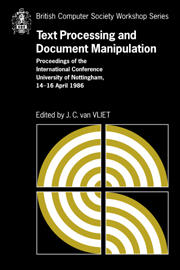 Text Processing and Document Manipulation
Text Processing and Document Manipulation Published online by Cambridge University Press: 05 May 2010
ABSTRACT
With the recent development of cheap highly functional laser printers and Raster Image Processors, there has been an upsurge of interest in languages for interfacing to these devices. An approach to the design of such a Page Description Language is described, the primary design requirement being a clean interface which is an easy target for translators from various front-end systems. The design of an actual PDL, the Chelgraph ACE language, based on these principles is described. Finally the ACE language is reviewed in the light of experience gained in its use.
Introduction
This paper discusses some issues relevant to the design of a Page Description Language (PDL). A PDL is a type of language commonly used for communicating page information from a composition system to an intelligent page printer. These languages are usually specified by the printer manufacturer as an input language, but device-independent outputs from some composition packages, for example DI-TROFF, are also PDLs. I also present a particular PDL, the ACE language, which has been designed by us at Chelgraph and implemented on our Raster Image Processor, the features of ACE itself have been described elsewhere [Chel84, Harris84].
What Is a PDL?
There have always been languages for communicating page information to typesetters and printers. Until recently the capabilities of computer output printers have been very limited, so their input languages have been simple ASCII formats modified by escape codes. Typesetters such as the Autologic APS 5, on the other hand, have quite complex input languages with a syntax and tens of commands.
To save this book to your Kindle, first ensure [email protected] is added to your Approved Personal Document E-mail List under your Personal Document Settings on the Manage Your Content and Devices page of your Amazon account. Then enter the ‘name’ part of your Kindle email address below. Find out more about saving to your Kindle.
Note you can select to save to either the @free.kindle.com or @kindle.com variations. ‘@free.kindle.com’ emails are free but can only be saved to your device when it is connected to wi-fi. ‘@kindle.com’ emails can be delivered even when you are not connected to wi-fi, but note that service fees apply.
Find out more about the Kindle Personal Document Service.
To save content items to your account, please confirm that you agree to abide by our usage policies. If this is the first time you use this feature, you will be asked to authorise Cambridge Core to connect with your account. Find out more about saving content to Dropbox.
To save content items to your account, please confirm that you agree to abide by our usage policies. If this is the first time you use this feature, you will be asked to authorise Cambridge Core to connect with your account. Find out more about saving content to Google Drive.